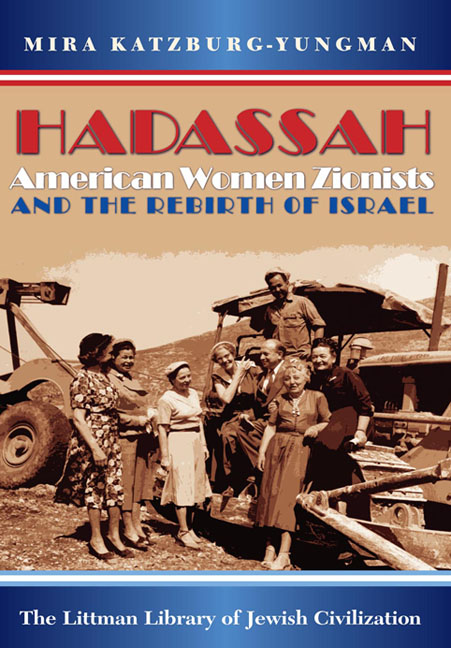Book contents
- Frontmatter
- Dedication
- Preface and Acknowledgements
- Contents
- List of Plates
- Note on Transliteration
- Prologue
- PART I CONTEXTS AND CHALLENGES
- PART II THE AMERICAN SCENE: IDEOLOGY AND PRACTICE
- PART III THE WORLD ZIONIST ORGANIZATION SCENE
- PART IV THE ISRAELI SCENE: HADASSAH AND THE NEW STATE
- 8 Hadassah in the War of Independence, 1947–1949
- 9 A Young State with Many Needs
- 10 Welfare and Education Projects for Children and Teenagers
- 11 Projects for Immigrant Children and Teenagers
- PART V HADASSAH IN CONTEXT
- APPENDICES
- Bibliography
- Plate Acknowledgements
- Index
11 - Projects for Immigrant Children and Teenagers
from PART IV - THE ISRAELI SCENE: HADASSAH AND THE NEW STATE
- Frontmatter
- Dedication
- Preface and Acknowledgements
- Contents
- List of Plates
- Note on Transliteration
- Prologue
- PART I CONTEXTS AND CHALLENGES
- PART II THE AMERICAN SCENE: IDEOLOGY AND PRACTICE
- PART III THE WORLD ZIONIST ORGANIZATION SCENE
- PART IV THE ISRAELI SCENE: HADASSAH AND THE NEW STATE
- 8 Hadassah in the War of Independence, 1947–1949
- 9 A Young State with Many Needs
- 10 Welfare and Education Projects for Children and Teenagers
- 11 Projects for Immigrant Children and Teenagers
- PART V HADASSAH IN CONTEXT
- APPENDICES
- Bibliography
- Plate Acknowledgements
- Index
Summary
HADASSAH'S WORK in caring for children and teenagers in Israel's early years laid a particular emphasis on the care of young immigrants, who in the early 1950s constituted some 71 per cent of all children and teenagers within the Jewish population of Israel. The proportion of youngsters (from birth to age 17) in the Jewish population grew from 34 per cent in 1947 to 37 per cent in 1953. Tens of thousands of youngsters arrived in these years, and the education they had received, if any, in the countries from which they came differed from that of their contemporaries in the Yishuv. As a result of the mass immigration, new social classes developed; these came to be known as ‘the second Israel’ (new immigrants from among the Holocaust survivors) and ‘the third Israel’ (new immigrants from Islamic countries). The widespread social and economic hardship in these groups presented a serious challenge to the young nation, and a large number of the children and teenagers among them would years later be recognized as ‘underprivileged’. At the same time there was a ‘frightening lack of professional workers [for children and youngsters] of all types’: teachers, educational counsellors, psychologists, psychiatrists, and social workers.
Hadassah's projects for immigrant children and teenagers are distinct from all its other projects, in that they had scarcely any American roots. In these enterprises Hadassah was a partner with other Zionist organizations. Some of them were longterm endeavours; others were ad hoc projects that Hadassah supported for a brief period only. The most important, from Hadassah's perspective, was Youth Aliyah, to which Hadassah allocated more funding than to any other area of its activity apart from health services (30 per cent of all funds raised went to Youth Aliyah, 38 per cent to health services).
HADASSAH AND YOUTH ALIYAH
Youth Aliyah was founded in the early 1930s, on the eve of the Nazis’ rise to power in Germany, for the purpose of encouraging young people to emigrate from that country to Palestine. Later it was expanded to include young people from other countries, and started to take care of children from the age of 6. Thus it became one of the major organizations dealing with children and teenagers in the Yishuv and in the early days of statehood.
- Type
- Chapter
- Information
- HadassahAmerican Women Zionists and the Rebirth of Israel, pp. 242 - 266Publisher: Liverpool University PressPrint publication year: 2011

